How to Reduce Overtime & Labor Costs in BPO
In this article, you will learn about how to reduce overtime & labor costs in BPO? Discover actionable strategies to cut costs without compromising quality. Learn tips & tactics for BPO efficiency.
5 min read
How to reduce overtime & labor costs in BPO companies can be a complex and challenging task.
Business Process Outsourcing (BPO) firms, especially those that operate call centers, often struggle with high labor costs, which can eat into profits. Overtime, in particular, can significantly inflate your payroll expenses. For mid-sized call centers, managing overtime costs effectively is crucial for sustaining profitability and maintaining competitive advantages.
In this blog post, we’ll dive deep into strategies and action plans that can help you reduce both overtime and overall labor costs without compromising on service quality.
According to a report by the International Labour Organization, excessive working hours can lead to higher turnover rates, increased absenteeism, and diminished employee productivity. Moreover, a research study by Deloitte reveals that labor costs constitute up to 60-70% of the total operating costs in BPO companies.
Thus, reducing these costs can have a substantial impact on your bottom line. To achieve this, we’ll explore the importance of data-driven decision making, optimized resource allocation, and technological advancements among other strategies. We’ll also provide actionable tips to help you implement these strategies effectively.
Understanding these strategies and their implications can help you not only to reduce expenses but also to create a more satisfied and productive workforce.
Read on to discover how you can optimize your operations today!
Utilize Workforce Management Software for Reducing Overtime

Workforce management software is a pivotal tool that can drastically reduce overtime and labor costs in BPO firms. These platforms help in scheduling, forecasting, and real-time monitoring of employee activities.
Accurate Forecasting: One of the crucial features of workforce management software is accurate workload forecasting. By predicting the call volume and client demands, you can schedule the appropriate number of employees accordingly. According to a survey by Aberdeen Group, companies that use workforce management software have seen a 57% decrease in overtime costs.
Automated Scheduling: Automated scheduling ensures that shifts are planned efficiently, taking into consideration employee preferences, availability, and skills. This minimizes the chances of over or under-staffing.
Pro Tip
Use analytics features in your workforce management software to identify patterns and trends which can inform better scheduling decisions.
Adopt a Flexible Work Model to Reduce Overtime Costs
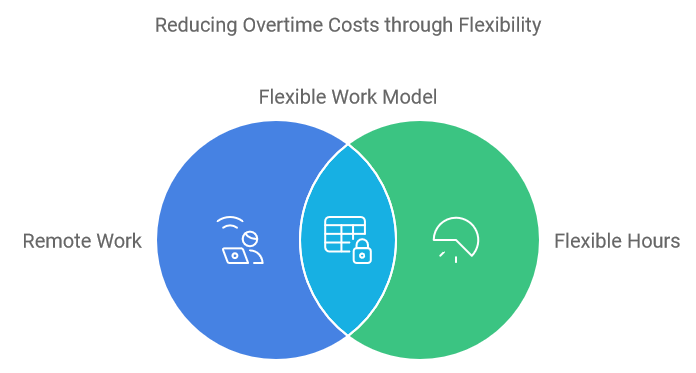
Implementing a flexible work model can be highly effective in reducing overtime and labor costs. This includes remote work, flexible hours, and part-time options.
Remote Work: Allowing employees to work from home can reduce overhead costs associated with maintaining office spaces. A study conducted by Global Workplace Analytics found that businesses could save up to $11,000 per employee annually by allowing remote work.
Flexible Hours: Flexible working hours enable employees to work during peak productivity periods, which can result in higher output and lower overtime.
Pro Tip
Offer job-sharing options, where two employees can share the responsibilities of one full-time position. This can be particularly beneficial during high-demand periods.
Implement Performance Incentives to Manage Overtime Cost
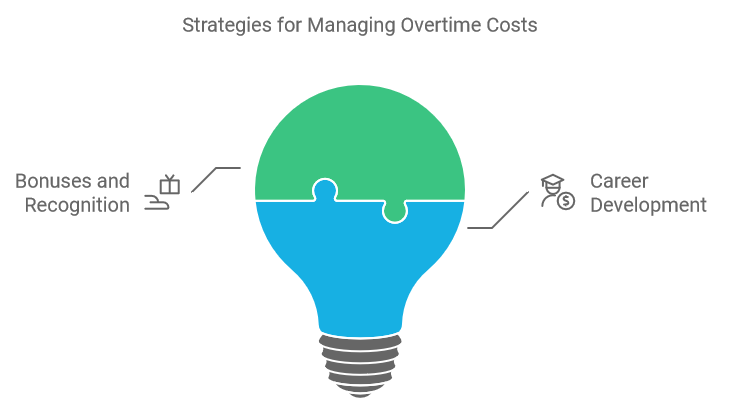
Incentives can motivate employees to perform at their best, reducing the need for overtime. These programs can include bonuses, recognition awards, and career development opportunities.
Bonuses and Recognition: Offering bonuses for meeting performance goals can encourage employees to work more efficiently. Recognition awards can build a culture of excellence, reducing the likelihood of burnout and absenteeism.
Career Development: Providing career development opportunities can make employees more skilled and efficient, thus requiring fewer hours to complete tasks. According to a study by LinkedIn, companies with strong learning cultures have 30-50% higher retention rates.
Pro Tip
Create a transparent and attainable incentive program to ensure employees understand how they can achieve rewards.
Streamline Operational Processes for Overtime Tracking
Streamlining your operational processes can significantly cut down wasted time and resources, contributing to lower labor costs.
Lean Management: Lean management practices focus on minimizing waste while maximizing productivity. Adopt methodologies such as Six Sigma to identify inefficiencies in your processes.
Standard Operating Procedures (SOPs): Develop clear and concise SOPs to ensure that all employees are following the same processes. This minimizes errors and reduces the time spent on reworking tasks.
Pro Tip
Conduct regular audits to identify and eliminate bottlenecks in your operational processes.
Leverage Technology to manage Overtime Hours
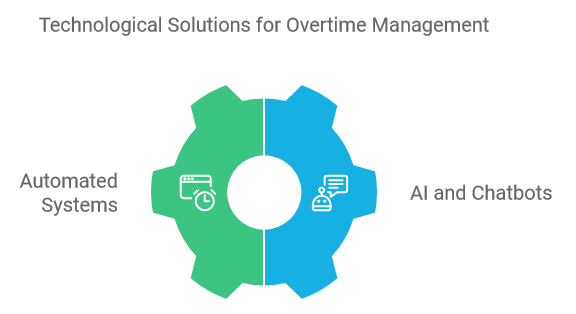
Technology can play a significant role in reducing both overtime and labor costs. Whether through automation, AI, or advanced analytics, modern time tracking tools and software can streamline your operations.
Automated Systems: Automation can handle repetitive and time-consuming tasks, freeing up employees to focus on more complex responsibilities. According to McKinsey & Company, automation can reduce labor costs by up to 30% in some sectors.
AI and Chatbots: AI and chatbots can manage customer service inquiries, reducing the reliance on human agents and potentially lowering labor costs. A report by Gartner suggests that AI could handle up to 85% of customer interactions in a few years.
Pro Tip
Invest in training programs to ensure employees can effectively use new technology, maximizing your ROI.
Enhance Employee Training To Reduce Overtime
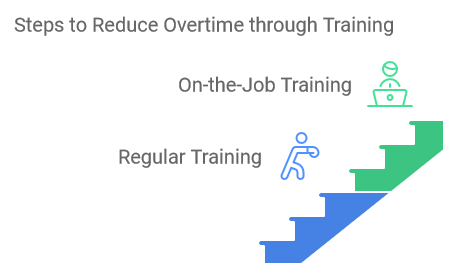
Training employees to be highly skilled in their roles can reduce the time it takes them to complete tasks, thus reducing the need for overtime.
Regular Training Programs: Conduct training programs that focus on skill enhancement and knowledge building. According to the Association for Talent Development, companies that offer comprehensive training programs have 218% higher income per employee than those that don’t.
On-the-Job Training: Provide on-the-job training to help employees apply what they have learned immediately, speeding up their development process.
Pro Tip
Use a Learning Management System (LMS) to track employee progress and identify areas where additional training may be needed.
Optimize Resource Allocation to Avoid Overtime Hours

Efficiently allocating your resources can prevent overstaffing or understaffing, which can both contribute to high labor costs.
Resource Mapping: Map out your resources to understand where they are best utilized. By aligning employees’ strengths with tasks, you can increase efficiency and reduce the time needed to complete tasks.
Demand Forecasting: Use demand forecasting to predict future workloads and adjust your staffing levels accordingly. This can help in avoiding last-minute scrambles that often lead to overtime.
Pro Tip
Implement an employee scheduling system that can quickly adapt to changes in workload and resource availability.
Maintain a Healthy Work Environment
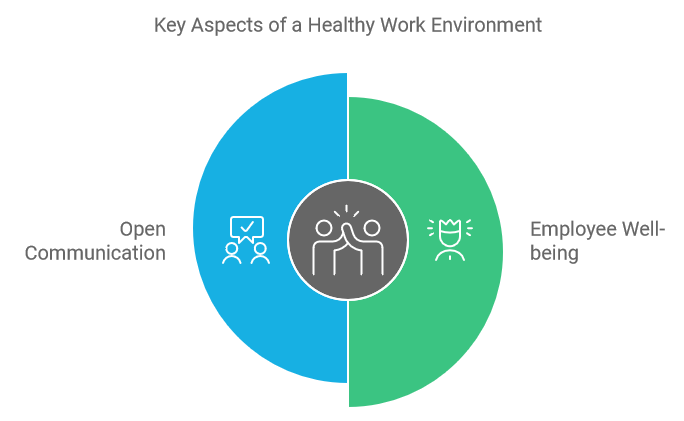
A positive work environment can lead to higher employee satisfaction, which, in turn, can reduce absenteeism and turnover, ultimately cutting labor costs.
Employee Well-being: Focus on employee well-being by offering wellness programs, mental health support, and regular breaks. According to a survey by the American Psychological Association, a positive work environment can lead to 40% lower turnover rates.
Open Communication: Encourage open communication between management and employees. This can help in identifying issues early and taking corrective action before they escalate into costly problems.
Pro Tip
Conduct regular employee satisfaction surveys to get feedback and improve workplace conditions.
Monitor Key Performance Indicators (KPIs) to Reduce Overtime
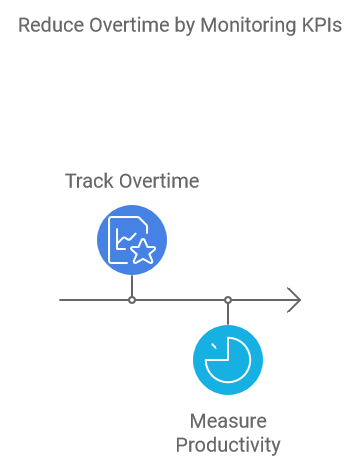
Regularly monitoring key performance indicators can provide valuable insights into where your labor costs are going and where you can make improvements.
Track Overtime: Keep a close eye on overtime hours and costs. Analyzing this data can reveal trends and help you adjust your workforce management strategies accordingly.
Measure Productivity: Monitoring productivity can help in identifying high-performing employees and areas where efficiency can be improved. This can lead to targeted training programs and better resource allocation.
Pro Tip
Use real-time dashboards to monitor KPIs, allowing for quick decision-making and adjustments.
In conclusion, reducing overtime and labor costs in BPO companies requires a multi-faceted approach involving technology, workforce management, operational efficiency, and employee well-being.
By implementing these strategies, you can create a more efficient, productive, and satisfied workforce, ultimately leading to a healthier bottom line.



